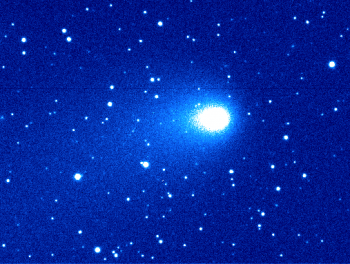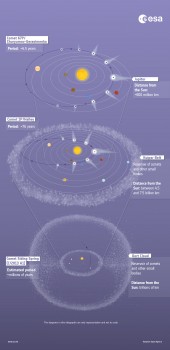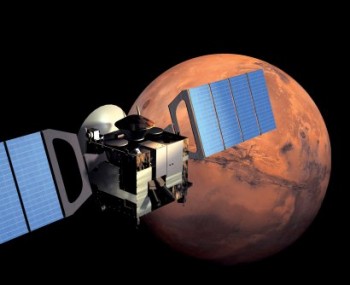This is a tale of two comets. One is a periodic comet, the other a newcomer to the inner Solar System. One has a well known and predictable orbit of six and a half years, the other is yet to complete its first million-year-long loop along a new orbit that has taken it, for the first time, in the vicinity of the Sun. One has been observed and studied for many years, while the other stayed well hidden until it popped up unannounced just over a year ago.

Comet Siding Spring observed on 19 September 2014 using the European Southern Observatory’s Very Large Telescope (VLT). At the time, the comet was at 1 AU from the Earth and 1.494 AU from the Sun. Credit: ESO/A. Guilbert-Lepoutre
These two comets are quite different. The predictable one is 67P/Churyumov-Gerasimenko (67P/C-G), a comet that was discovered in 1969 and is currently being visited and studied up close by ESA’s Rosetta spacecraft. With an orbital period of under 20 years and a low inclination, 67P/C-G is classed as a “Jupiter-family” comet — we know of many comets belonging to this family.
The other comet is C/2013 A1, also known as comet Siding Spring after the observatory in Australia where it was first observed in January 2013. (Note: another comet discovered in 2007 at the same observatory is also known as Siding Spring: comet C/2007 Q3.)
Comet Siding Spring is currently on its first journey to the inner Solar System; it has spent most of its life in the Oort cloud, a gigantic reservoir of comets that surrounds the Solar System and stretches outwards to roughly 100,000 AU from the Sun — where 1 AU is the Earth-Sun distance. Comets in the Oort cloud are dormant, but even a small perturbation can modify their orbits and kick them into the inner Solar System; this is what happened to comet Siding Spring a few million years ago.

The different orbits of two periodic comets, 67P/C-G and 1P/Halley, and the Oort cloud comet Siding Spring. Credit: ESA
When this comet was first discovered, it was 7.2 AU from the Sun, placing it somewhere between the orbits of Jupiter and Saturn. It will reach its closest point to the Sun, at about 1.4 AU, around the orbit of Mars, on 25 October 2014, before heading back out towards the outskirts of the Solar System.
Comets are fossils from the Solar System’s early days, and still contain some of the primordial material that made up our system’s planets. While periodic comets, with their frequent passes close to the Sun, may have evolved and lost part of the original material, Oort cloud comets are more pristine, having spent billions of years untouched, far away from the Sun. Their material has been much less processed, making them an even richer trove of information about the formation of the Solar System 4.6 billion years ago.
However, Oort cloud comets are extremely unpredictable and, unlike their dependable Jupiter-family relatives, they can come from any direction in the sky. When distant from the Sun, Oort cloud comets are very dim and difficult to observe, so they are usually discovered with extremely short notice before they whirl around to begin their trip back to oblivion. Astronomers can study them from ground-based observatories during this short interval – a few years at most – but it is virtually impossible to plan a space mission to fly near to such a comet.
This is where comet Siding Spring stands out. One week prior to its closest approach to the Sun, the comet will also pass extremely close to Mars. In fact, after its discovery, scientists even considered the possibility of a collision with the Red Planet – an option that was excluded as soon as the comet’s orbit was determined with greater accuracy. The encounter will be of a very close kind; on 19 October, comet Siding Spring will pass about 140 000 km from Mars.
What makes this close approach truly historic is the presence of various spacecraft currently operating at Mars. Siding Spring’s close encounter offers these craft an unforeseen perk: to perform a flyby of an Oort cloud comet.
The distance that will separate comet Siding Spring from Mars and the fleet of spacecraft around it does not even begin to compare to the mere tens of kilometres that are currently between Rosetta and comet 67P/C-G [*]. Spacecraft that flew by comets in past decades have also reached much closer distances, ranging from a few tens to a few hundreds of kilometres.
Those were all periodic comets though, and this kind of flyby is not an option for an unpredictable Oort cloud comet. The spacecraft on and around Mars have a truly unique opportunity to study such a comet from a distance that could hardly ever be achieved otherwise. The orbiters will observe Siding Spring’s nucleus and its enveloping coma, as well as monitoring the Martian atmosphere during the comet’s approach.
Joining the observing campaign as part of ESA’s Solar System fleet will be Mars Express, which is currently orbiting the Red Planet. This spacecraft has started observing comet Siding Spring last Monday, and many more observations are planned for the coming days just before and after closest approach. The comet’s activity is currently moderate, meaning that the risk of dust grains impacting Mars Express is extremely low — this will allow the spacecraft to operate safely during the comet’s closest approach to Mars.
The High Resolution Stereo Camera (HRSC) on Mars Express will image the comet’s nucleus, although it is unlikely to resolve it fully. The camera will also be used to observe the coma and to study the behaviour of the comet’s trailing debris of small meteors. Other instruments on Mars Express will perform measurements to study the composition of the coma and to learn how the cometary material interacts with both the Martian atmosphere and the wind of charged particles streaming outwards from the Sun.
Read more about Europe’s Mars orbiter observing Siding Spring from the perspective of Spacecraft Operations in the Mars Express blog. Updates will be posted on the blog leading to closest approach, and a webcast from the European Space Operations Centre, Darmstadt, Germany, will be streamed live 19 October, starting at 19:50 CEST.
Other missions that will participate in the observing campaign are NASA’s Mars Reconnaissance Orbiter, Mars Odyssey orbiter, and the Mars Atmosphere and Volatile EvolutioN Mission (MAVEN), and the Indian Space Research Organisation’s Mars Orbiter Mission – the last two having only reached the planet in late September 2014. NASA’s two rovers, Curiosity and Opportunity, will also observe the comet from the surface of Mars.
This rare opportunity to get up close and personal with an Oort cloud comet will allow astronomers to collect different, but complementary, information to that gleaned from observing periodic comets. This is not a tale of one comet, or even of two – it is the tale of our Solar System and its history. The more comets we explore, the more clues we can gather to piece it all together.
[*] While the current orbit of comet 67P/C-G takes it quite close to the Sun, with closest approach (perihelion) at about 1.3 AU and an orbital period of only six and a half years, this has not always been the case. In fact, analysis of the comet’s orbital evolution suggests that 67P/C-G has only been on this orbit since 1959, when a close encounter with Jupiter brought it closer to the Sun; prior to that, its perihelion was at just under 2.8 AU. This comet has quite a history of close interactions with Jupiter: orbital calculations show that its perihelion was as distant as 4 AU until 1840. This means that 67P/C-G is only a recent dweller of the inner Solar System, and so its material remains reasonably unprocessed.










Discussion: 23 comments
Hi Claudia. Do we know if 67P was ever actually in orbit around Jupiter? I read that some Jupiter class comets have been in the past.
What we know is when it was discovered and its orbit since then. Everything else is guesswork. It might have left the Oort cloud a billion years ago and passed earth once or twice it might also be a creation as young as a few hundred million years and its place of birth was the asteroid belt where a passing comet collided with an asteroid. Just anything can be possible in the huge dynamic scale of space and time of our solar system. More complex things then this lump are present right upon our noses.
Thinking twice, the Kuiper belt has a few thousand observed inhabitants the rest is extrapolation, nobody knows its outer limit or if there is any. The Oort cloud is fictive and should be banned as disinformation. From the inner parts of the Kuiper belt the orbits are in the range of a few hundred years. In this belt no one can claime that any object have stable orbits. The large planetoid objects have orbits that last for quit some time as the orbit of pluto and charon crossing the orbit of neptune, this is to me semi stable. The smaller not yet observed lumps can have any chaotic orbits at your choice.
Hi Robin,
Comets are either bound to the sun, or they are satellites (like Triton – a Kuiper Belt object which got trapped around Neptune during the early chaotic dynamical evolution of the Solar System). If a comet got trapped around Jupiter, it would be really hard to escape its gravity, so this sounds unlikely for 67P.
Do you have any references about the Jupiter-family comets you are talking about? Thanks.
Hi Claudia. Thanks for the reply. You will be unsurprised to learn it was in a Wiki article, but I’ve looked up so many over the last few weeks I can’t remember which one. It did surprise me at the time, probably why I remembered it. Not impossible, but I would have thought highly improbable. Objects can be thrown out of solar systems, Jupiter’s mini system as well, I figured.
Time to make some predictions about comet Siding Spring.
1) nucleus (or nuclei) will have very low albedo (about the same as periodic comets .05)
2) Multiple nuclei, that will move to separate orbits after the Mars encounter.
I don’t think, that just because the orbit is so long, that it means it is the first time into the solar system. You can fit a lot of million year orbits in a billion years.
The part of the large nebula that once was the origin of our solar system was not a dull place where nothing was going on. Other solar systems where created and a lot of comets as well, some of them never in the vicinity of any solar system. The really great thing is that we are ashes of an old star and its death created the possibillity to make things a bit more complex until the stage where complicated mollecules formed and due to a lot of very rare opportunities and changes they became so complex that they started to make Blogs.
About the Oort cloud origin of Siding Spring, this is based on the shape of its orbit. The orbit was computed using the first few observations of the comet, and estimated to be hyperbolic. Within the errors, this means that the comet is either coming from the Oort Cloud or from outside the Solar System.
The Oort cloud is nothing but a place to stuff comets that are not possible to predict the orbits of. We get the sight of a new comet and we measure its trajectory, then we realize that its orbit is over thousands of years and call it hyperbolic and say its origing is comet heaven. All extremely long period comets have chaotic orbits and they are not predictable, once or never coming back is a matter of chance and looking on the moon shows where some of this chaos ended. In our lifetime we are able to see quite a few comets due to modern technology, most of them in orbits under a few hundred years and not even those are predictable as even the very short period 67pgc has changed its orbit since it was first noticed. In the realy long time scale all comets are going to end up colliding with a planet or disapearing to another star in our vicinity. Scientists like to measure and predict but in this case a good guess is just as much worth as anything and then we can stuff the measurement failures away into the Oort clouds for some time. Its actually the same procedure with measurements of the universe at large and the creation of ideas like dark energy and dark matter. To me our scientists sometimes remind me of the alchemists that tried to make gold out of lead. The alchemists as well as our modern scientist ended up making a lot of worthless things out of gold.
The last chance to catch a snowball?
Has anyone verified whether any of Mars’ moons are any where near this comet pass over Mars
Dear Steven,
The moons will be close to the comet, with Phobos’ orbit at ~6000 km from Mars and Deimos’ orbit at ~20000 km, and there will be some impacts of comet dust particles on the moons.
You can find more information about it in the presentation by M.Horanyi at the Comet Siding Spring Science Workshop from 19 September 2014: https://cometcampaign.org/second-workshop#
This should be an exciting encounter.
No it was not
A damp squib!
You know NASA will make a big fuss over the results of their investigations to steal the limelight from ESA, Rosetta and Philae in about two weeks time. NASA has been upstaged big style, and I don’t think they like it.
The big laugh was the poster made by a NASA artist of a snow-white 100% albedo comet full of streamers in front of a mars image, to learn is the hard part of life.
Just for the record, would the standard model predict a reflective, smooth, icy surface of the nucleus? I believe it will look very similar to 67P and thus refuting the origin of the hypothetical Oort Cloud.
Another comet just passed. No snowballs once again. All the talk about hyperbolic orbits is ridicules as there are no hyperbolic orbits anywhere around. Orbits are aether elliptic to circular or chaotic, such a close encounter with Mars changed its orbit once again to anything that is not predictable. I think scientists solving problems never get to the stage where it is said congratulations to the team and lesson learned.
To compare the so called science reports before and after the mars passage confirm the fact that scientists like to stick to their old habits and are prone to colorise their reports in desperation with spectacularity to get some attention. Fresh animations and pictures still stick to the old and worthless models and once the attention is cooled down they hope nobody noticed their errors.
How did the scientists evaluate the shape of the orbit and what are those few observations of the comet which had lead to the speculations of its existence in to solar system either frm Oort cloud or oitside solar system?
By observing it with high precision telescopes measuring its position in time and then calculating its orbital parameters. This method is generally done for all observed bodies in our solar system and the errors are quite huge. Remember the ammount of propellant onboard the Rosetta to be used to correct the errors in ist long journey. Also the orbital parameters of planets need to be updated once in a while as they do not travel in absolutely perfect orbits and are affecting each other.
Finaly to predict where this comet came from and where it is going is easy as the Oort cloud is an established theoretical place to stuff the errors away. Hyperbolic trajectories are not existing other then in theory and so is the Oort cloud. Very long period comets have nothing but chaotic trajectories. Chaotic means it is not predictable at all no matter how hard you try. The tiny Siding Spring comet could returm within a thousand years or never come back again or colliding with something outside our field of view.
To emphasise this I must remind of the collision probability estimations made from the discovery of the comet until it passed and also the estimation of the size of the comet during this time. The amount of the errors made is quite embarrassing taking in account that the so called scientist had the very best of instruments available to make their predictions.
Anybody have a link to data released on Siding Spring? Images too !!
Thx
Thank u very much cometstalker…It was very Informative…